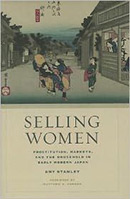Selling Women: Prostitution, Markets and the Household
in Early Modern Japan
 Author: Amy Stanley
Author: Amy Stanley
Publisher: Berkeley, CA: University of California Press, 2012. 256p.
Reviewer: Sam Bieler | January 2013
Challenging Eurocentric perceptions of prostitution in early modern Japan, Amy Stanley’s Selling Women: Prostitution, Markets and the Household in Early Modern Japan tracks the changing status of Japanese sex workers. Drawing from an extensive array of primary sources and utilizing a compelling narrative structure, Stanley explores the changing status of Japanese prostitutes as economic actors simultaneously castigated for destabilizing the social order, and relied upon as drivers of the prosperity the Tokugawa Shogunate needed to govern. Stanley concludes that contrary to expectation, as prostitutes attained greater economic freedom, they lost numerous legal protections.
The vivid and engaging quality of Selling Women is in its narrative style. Drawing from diaries and criminal registers, Stanley focuses on individuals, relating personal stories to bring into focus a broader picture of the sex trade in Japan’s major cities, ports, highways and villages. Tracing the development of prostitution through connected individual accounts creates an incredibly readable history that gives voice to these women’s experiences. Stanley binds each of these stories together to generate clear theses about each age and geographic area covered. Through the stories Stanley unfolds the history of prostitution across the Japanese Islands by means of the women who operated in a maze of social expectations, economic pressures and political mandates.
Tracing the history of this politically and morally charged profession reveals an unforeseen yet fascinating point: these women’s ascension as independent economic actors removed a number of legal protections prostitutes enjoyed in more economically restrictive eras. As they asserted their identities, prostitutes became unable to use societal mores to encourage or compel authorities to act on their behalf. Liberated from family-based identities, prostitutes in the 19th century had a greater degree of economic freedom than ever before, but faced more stringent attacks on the morality of their profession and their effect on Japanese society. The paradoxical coexistence of greater agency and fewer political and social protections is a point that merits connection to a broader body of literature.
Given her excellent development of the opposite legal and economic trends, Selling Women could have benefited from a more developed connection to the alternative viewpoints it occasionally references. At the end of the chapter on prostitution in the 17th century Stanley briefly notes that feminist scholars consider the Japanese legal system of this period to be entirely negative for women, and while she adroitly contests certain critiques of the place of prostitutes in Japan, she does not capitalize on the chance to draw broader conclusions about existing interpretations of the position of Japanese women. Given the superbly supported central argument, not connecting the work more thoroughly to the larger dialogue on gender seems a missed opportunity.
This is, however, only a minor critique of a compelling and meticulously researched piece on the evolving place of prostitutes in Early Modern Japanese culture. Diligent research makes this an excellent source for scholars of Early Modern Japan, but the persuasive narrative structure will make it a worthwhile read for even casual students of Japanese history.
Sam Bieler is a Research Associate at the Urban Institute


